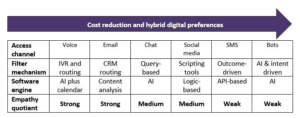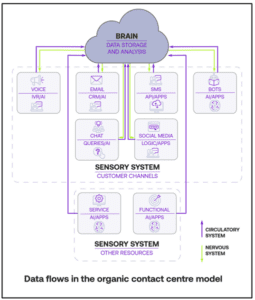
Jas Bansal
Head of Marketing, Kerv Experience|Kerv Experience
Have a question?
Get in touchPublished 14/06/22 under:
We all know what’s meant by an omni-channel contact centre, of course. It’s a platform that integrates digital, online, and analogue media for fulfilling inbound and outbound customer interactions. And we know what empathy is too. It’s the ability to understand and share the feelings of others. But now consider combining the two. Perhaps easy-ish when you’re talking about voice; maybe not so in the digital domain. The purpose of this blog is to suggest how to start achieving empathy across digital channels and realise the desired reconciliation.
Organic contact centre model
A study by MyCustomer and Genesys asked how successful today’s organisations are in catering for their customers’ emotional needs, and how striving for empathy impacts customer relationships. Nearly 75 percent of respondents believe it’s especially important there’s compassion during customer interactions. Over one-third said their emotional state was not well served.
At the heart of the problem – and, paradoxically, a significant element of the solution – is another buzzword in common use: data. Once regarded as sterile, static, and practically useless, in today’s omni-channel contact centre world the value and volume of data and its applicability have sky-rocketed. Not for nothing has data analytics become a science all its own.
The mind shift required is to consider the contact centre as a living thing. Its principal organs would be the brain (data and analytics) and the sensory system (connections with the outside world through channels like voice, email, bots mobile chat, webchat and social media, and technologies like IVR, AI and SMS). A circulatory system would collect data and stream it to the brain for processing, with a nervous system distributing outputs and managing channel interactions.
Disrupting the empathy equation
This organic model may help us reconsider how we think about empathy, while making better sense of our relationships with customers.
In this blog we’ll deal primarily with inbound traffic where, irrespective of channel, the widely accepted six expectations of an empathic relationship are the ability and readiness to:
- Greet the customer by name
- Know their history
- Not ask them to repeat information they’ve already provided
- Instantly understand their requirement
- Resolve the problem or satisfy the need (including transfer) during the first contact
- Fulfil promises made
The pandemic drove a shift from inbound voice calls to digital and online channels, which disrupted the empathy equation. But COVID-19 wasn’t entirely to blame. Contact centre cost reduction strategies aimed at lowering call volumes and cutting human agent numbers through automation have added to the effect. In this lean environment an inverse empathy hierarchy has emerged, as depicted in the following chart.

The unfortunate effect has been to move customer interactions across to those channels (on the right in the chart) where it’s not so easy to show and exercise empathy.
What the market view tells us
Against that background, with its Banking on empathy study, Accenture took the microscope to the retail financial services industry. Just like other sectors, the survey indicated a massive shift to digital, with 50 percent of consumers interacting through mobile apps or websites at least once a week, nearly double the behaviour of two years ago.
Alongside, the MyCustomer and Genesys report said making your customer feel remembered and understood is the foundation of an empathetic experience. It found that:
- 70 percent of customers say they are very satisfied with queries met with empathy
- Loyalty leaders grow revenues 2½ times faster than industry competitors
- Firms able to respond to customers’ emotional states outperform their peers
In a digital world that predicates collecting and analysing the right data to anticipate the assistance a customer might need i.e., intelligent use of data can confer empathy onto channel behaviours previously regarded as unintelligent.
Exercise better-informed analysts
Returning, then, to our organic contact centre model, streaming paths are needed for the brain to collect and analyse masses of data arising, for example, from channel interactions or harvested from social media. A frequent mistake is to drop data into separate systemic, product, physical, or financial siloes. A common example is the split between service-related information and sales-related data; few organisations have them operating in harmony.
Better-informed analysts would arrange the data according to empathy-affecting attributes. In so doing they would bring insights to life so the company would know its customers in more detail than the incomplete picture unconnected legacy systems usually provide.
Achieving such insights takes process alignment to help unify customer data and make it useful as a tool to transform customer interactions. That empathy-driven data would enable businesses to respond to their customers while adapting to rapidly changing needs seen in real-time data. Companies are learning that requires a radical architecture to offer a single customer view and allow access to information needed to deliver empathetic customer experiences. Also, as an aside, it would require an ethos that rewards excellence in data management.
Build a virtuous cycle
Delivering empathetic customer experiences requires businesses to create an implicit understanding with the customer to encourage meaningful data exchange. To build that trust requires a virtuous cycle; improving their experiences would be the quid pro quo. Also, introducing customer listening and analysis technology to collect feedback at every stage of their journey would help translate that invaluable data into actionable insights.
So, connect everything by investing in integrated technology – automated, where possible – and systems that form a unified view. At the same time, rationalise customer data sources for an overarching view of interactions and outcomes. Furthermore, find and connect new and/or missing data sources to complete the 360° perspective.
Then, to deliver empathetic customer experiences where it counts most, assess and prioritise highest-value critical customer touchpoints for digital empathy. Analyse the journey to find which cause the most heartache and have the greatest business impact. Arrange them around a centre of excellence, from which everyone can adopt best practice.
Organise and energise distribution
As shown in the chart, the nervous system’s return path should organise and energise distribution routes to drive digital channels, using empathetic data as the catalyst for CX transformation. With logically arranged data this may be easier than at first appears.

AI is key to providing insightful answers and helping customers achieve what they want. For example, an AI engine could use data to adduce the customer’s preferences and reorient software-based predictive routing decisions based on that insight. Irrespective of where the customer alights, we need to anticipate such events even before they make an enquiry.
Other organic-type strategies could use advanced speech analysis (see ‘customer listening’ above) to identify people adjudged to be stressed and direct them to channels where empathy can best be employed. Either transferring them straight to a human agent or to an automated response with the right answer inferred and immediately to hand.
Evaluate rigorously
To create more intelligent bots, AI rules should interrogate the brain for empathetic data like first name or recent history, again literally before the interaction has started. Moreover, manual or auto analysis of customer journeys should identify instances where customers (still too often) are asked to enter the same information twice and eliminate (or flag) discrepancies in the logic.
Finally, in our work with local government organisations, we’ve encountered enlightened councils where bots are evaluated rigorously. One council leader said: “We’ve got tech champions for new bots. People who evaluate the functionality give us feedback on its logicality and advise on how we can make it better, more intuitive, and more user friendly.” We’ve also met those unfortunates who’ve rushed ambiguous bots to market, sometimes with newsworthy results and often to citizens’ extreme irritation.
Have a question?
"*" indicates required fields






